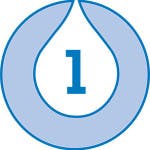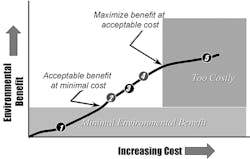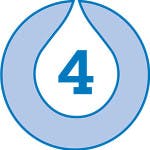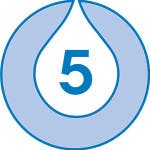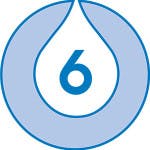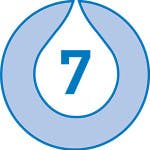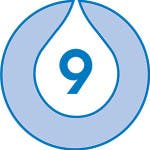Its déjà vu all over again. Sitting in a conference room with a number of city and county representatives (and even a permit writer) talking about principles and direction for Phase II stormwater-quality programs reminded me of a time over a decade ago when we were just beginning the Phase I National Pollutant Discharge Elimination System (NPDES) program. After a particularly long afternoon of discussion concerning best management practices (BMPs), pollution removal efficiencies, the definition of “maximum extent practicable” (MEP), monitoring approaches, and financing alternatives, one particular client city stated, “if only there were some easy way to understand how to think about where to go with this program—you know, like the Ten Commandments or something. If the Almighty can boil all of human morality down to 10 simple statements, surely we can do it for this stuff.” That conversation (and several nights of beer and pizza with old stormwater folks) led to considering the best (and the worst) examples and experiences from leading cities across the country and to the development of the 10 “commandments” for the growth of NPDES Phase I stormwater-quality management programs.
A lot has changed since that time. We’ve all gotten older, and a few have even gotten smarter. So I decided to poll a few friends (the ones who have gotten smarter) about what they considered some of the most important things to think about when considering Phase II stormwater programs. What key commandments should guide us when we think about what it might take to establish an effective Phase II stormwater-quality program in a smaller city or county (or borough, township, district, or big prison)?
This article is about what they had to say—the “Phase II Ten Commandments.” Some of the truths contained in these commandments have withstood the test of a number of cities of different sizes and in different environments. Some simply point a Phase II municipal separate storm sewer system (MS4) generally in the right direction to be in step with future changes in stormwater management. They can be convenient guidance for even the most nontechnical program administrator or city council to help ensure the Phase II program starts and stays on course.
Now don’t get too uptight about the commandments. If this is anything like trying to figure out if “stormwater” is one word or two, there will be a lot of quibbling about this list. Heck, where I live, the commandment about coveting your neighbor’s wife would probably be well replaced with proscriptions against leering at his John Deere 6300L. So change away. It’s still a good starter list. And for the old experienced hands, it will give you a chance to say, “All these I have kept from my youth up.”
While the drivers for change in the way we do stormwater management in past decades were grassroots and physical—failing systems, clogged pipes, flooded neighborhoods—the drivers today are often regulatory or legal. Total maximum daily load (TMDL), the Endangered Species Act (ESA), drinking-water and wellhead protection, effluent limits, and more will come along in due time to nearly every community. They cannot be avoided.
Every department, not just the public works folks, will be affected in some way. A health department will consider septic tanks differently. Floodplain management will inevitably shift from a single-focus flood protection and development permitting strategy to stream protection, riparian corridors, buffers, and floodplain recovery. Site designs will move from efficient drainage systems to environmentally effective systems—retaining and infiltrating as much rainfall as possible while protecting property, often called “low(er) impact development”. Schools will increasingly be asked to focus on water conservation and habitat protection issues as part of the public education responsibility. Citizens will seem to be involved in everything. Zoning ordinances will include, at the least, an environmental overlay district planned unit development (PUD) option. Our field personnel will need learn how to pleasantly and articulately introduce and educate homeowners about that “rain garden” in their front yard as part of their daily job.
Hopefully, this time around a more organic and integrated approach will happen. But it is much harder to bring that about in a small town lacking resources. It is incumbent on these entities to recognize that from this point forward they will be transforming themselves, willingly or not, into integrated quantity and quality programs with coordinated multidisciplinary teams. Pull the team together early and begin planning the transition.
So how expensive will Phase II be? There have been several atttempts to estimate the probable costs of the NPDES Phase II stormwater program. EPA’s overall annual estimate for all permittees is nearly $1 billion. Most individual MS4 estimates are expressed in terms of cost per person per year, though the actual costs do not always lend themselves very well to this yardstick. EPA itself, based on data and surveys, establisehd its cost estimate as $1,525 + $3.50 per person, though the numbers are laughably vague in terms of actual data.
Another way to arrive at the potential cost is to recognize that most MS4s that have already implemented a fairly advanced stormwater-quality program spend about 15–25% of their total stormwater dollars on stormwater-quality aspects—a subset of which is Phase II compliance.
Assuming typical numbers of about three persons per acre, and that stormwater-quality compliance aspects make up roughly 15% of the program, then for a moderate program, the cost of the stormwater-quality program is in the range of $3.75–$6.00 per person per year.
The fact that cost should and can be considered when developing an MEP program is incontrovertible—to what extent is a source of controversy and must be balanced with other considerations.
Cost-Effective
Language throughout the preamble to the permit and in the congressional record describing MEP definitions also contains the term “cost-effective” when it describes BMP programs. This term has not been defined but can serve as a critical basis when selecting among BMP options, the level of the stormwater-quality program, and funding needs.
Because it is difficult to evaluate cost-effectiveness in absolte terms, most cost-effectiveness analyses seek to determine effective programs relative to other potential options. The goal is not to lead to perfect environmental or economic solutions, but to elevate the decision process above the often emotional cost-oblivious argeuments. Thus we see several things about cost and the MEP program we are developing:
- Cost can be a factor in a program planning and implementation.
- Cost cannot be the reason for doing a poor job.
- There should then be a process for cost-effectiveness analysis that must work when benefit and cost are measured in different ways or are squishy.
Figure 2 shows steps in a typical cost-effectiveness analysis modified to fit a Phase II program.
1. Establish Key Focus and a Complete Program. Define the goals and objectives of the overall program, focusing on solving apparent water-quality problems or protecting key assets or resources, while keeping in mind the need to have a program under each of the six minimums.
2. Define the Universe of Possible Solutions. Brainstorm and screen individual and combinations of BMP programs (both structural and nonstructural), including cost or resource estimates, potential type and availability of funding sources, fit with local program, ability to impact the goals and objectives, level of expected impact and benefit, and mutual exclusivity.
3. Perform Basic Cost-Effective Analysis. Seek to eliminate inefficient and ineffective (economically irrational) solutions. Often a certain level of environmental benefit, or program level, can be obtained in several different ways. Figure 3 illustrates the concept.
4. Perform Incremental Cost Analysis. The next goal is to answer the question, “Is the increment in environmental benefit worth the increment in cost?” For each cost-effective BMP, a range of effort and cost may be defined, as well as—if—possible a range of environmental outputs in response to that effort input range.
5. Configure the Program. Blend the various BMPs into a cohesive program, seeking synergy and practicality.
Commandment #4: Thou Shalt Build a Firm Foundation
This figure, then, can serve as a useful organizing tool for an MS4 or regulator to look at the various BMPs in a program to see if they have a good chance for success. Each of the six minimum controls is expanded for each BMP sub-program, and each one is subjected to the foundations analysis framed by the four questions.
Consider two opposite theories of program development. You may want to do more than the minimum acceptable but may not want this “more” to be a regulatory concern (in case it does not happen), so you would attempt to negotiate the minimal acceptable (we call it mEP) program, and plan to do more because you want to. On the other hand, to make sure it actually happens, you may want the whole program to carry the weight of regulatory oversight and define and negotiate a more comprehensive package. If you work in local government, you know why.
Commandment #5: No Diving Into the Pool
Public education, awareness, and reporting and other nonstructural programs can be easily modified or abandoned if they prove to be ineffective or to address a non-problem. Employ measures which have high public, political, and “stakeholder” acceptance. Get private vendors to purchase advertising allowing their logos on environmental messages on stencils, signage, and billboards. While adults may not willingly change their lifestyles to reduce pollution, their children might—especially if it bugs dad. Many school programs eventually influence parents to recycle, become citizen stream monitors, and volunteer in cleanup programs. The scouts have an environmental badge.
In terms of pilot and phased programs, set up programs to be developed in well-defined phases and steps with checks of effectiveness at every major milestone. Proceed slowly and cautiously with in-course corrections. Look for methods with few environmental side effects, and that do not introduce unacceptable risks to health or safety. The NPDES permit process allows for annual reporting. Use these reports to request and negotiate changes in the conditions of the permit based on information gleaned from the previous year(s). Define a permit application with several options based on results of pilot studies and phased programs. Specify the “out” if things do not seem to be working—do not commit to a five-year sentence in a nonviable programmatic prison.
You are changing your paradigm; it takes time.
Commandment #6: Thou Shalt Ride the Treatment Train
Smoking is now so politically incorrect in California that you have to go to Nevada to light up. Begin to change public opinion about local streams and other receiving waters in much the same way the public has changed its overall opinion on smoking and a host of other issues. For example, the goal would be that through a combination of education and recycling-availability programs oil recycling would become common, dumping rare.
Cars in the Train
At the top end of the physical watershed, other BMPs combine to remove pollution at its physical source. Land-use design modifications and micro-scale structural BMPs are integrated into zoning and subdivision ordinances, environmental overlay districts, “zero discharge” ordinances, better site design, low-impact development, and so on. Other nonstructural BMPs would also be used, such as street sweeping, construction site controls, and an effective illicit connection program. Sometimes the top of the watershed is outside your control.
Stormwater then moves to conveyance where system conveyance structures incorporate pollution-reducing features such as filtration and infiltration. Some commercial devices may also be employed here at the entrance to the conveyance system or at junctions. At end points within the system, larger, often multipurpose, stormwater quality/quantity controls are put in place to handle larger volumes of flow or to provide “polishing” of the discharge. Finally, in-stream habitat conservation and preservation practices are integrated with natural (or “nice” urban) channel designs targeting key benthic and fish communities, as appropriate.
Obviously this sort of thing works best when we begin with a clean slate in an affluent environmentally conscious community. For the 99% of us who do not have that luxury, we begin to work on various components of the treatment train approach and, over time, evolve into a working concept that fits our community. We look for retrofit opportunities and, at a minimum, integrate nonstructural, nonphysical BMPs everywhere (e.g., education or illicit connections removal).
Commandment #7: Thou Shalt Make the Most of What Thou Hast
A shift to environmentally sound private development doesn’t just happen because there is a zoning ordinance change or a set of new design criteria. But there may be a need for legal ordinance and regulation changes early in the program development process. To be effective, it involves a tremendous number of things and a guided community partnership process. Educate and enable developers to make the changes. Work cooperatively and regionally. Amazingly enough, many developers welcome the ideas of better site design—and not for altruistic reasons. Take a watershedwide approach to planning. The Center for Watershed Protection has developed a good approach in the Site Development Roundtable.
Tools and Approaches
There are a number of tools and approaches that have been tried successfully—and a ton of literature on such topics as sustainable development, smart growth (as opposed to “dumb growth,” I guess), better site design (ditto), low(er) impact development, zero discharge, and green infrastructure. In summary, these things involve a suitable combination of elements sure to make friends in high places:
- Environmental site design ordinances, overlays, and/or zoning requirements
- Modified development and permitting requirements and procedures
- Changing public and developer perceptions
- Multiobjective use of protected and conserved areas
- Financial incentives or waivers
- Changed public level-of-service and extent-of-service policies for maintenance
- Partnering with nonprofit organizations
- Integrated stormwater-quality infrastructure
- Alternate building and paving materials and approaches
- Modified design specifications and stormwater criteria
- Education and training
- Pilot projects and public/private partnerships
- Alternative funding
- Holistic master planning with early identification of critical areas
Admit early on that there will be some trial and error no matter how successful that East Coast county seems to be.
Commandment #9: Thou Shalt Make Friends in High and Low Places

